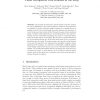57 search results - page 5 / 12 » The Nakamura numbers for computable simple games |
CORR
2007
Springer
13 years 8 months ago
2007
Springer
Abstract—In this contribution, the performance of a multiuser system is analyzed in the context of frequency selective fading channels. Using game theoretic tools, a useful frame...
SIROCCO
2000
13 years 10 months ago
2000
: We consider a well known distributed coloring game played on a simple connected graph: initially, each vertex is colored black or white; at each round, each vertex simultaneously...
ECCV
2010
Springer
14 years 1 months ago
2010
Springer
We present an interactive, hybrid human-computer method for object classification. The method applies to classes of objects that are recognizable by people with appropriate expert...
FOCS
2004
IEEE
14 years 9 days ago
2004
IEEE
We prove the existence of tolls to induce multicommodity, heterogeneous network users that independently choose routes minimizing their own linear function of tolls versus latency...
GECCO
2003
Springer
14 years 1 months ago
2003
Springer
The MasterMind game involves decoding a secret code. The classic game is a code of six possible colors in four slots. The game has been analyzed and optimal strategies have been po...

